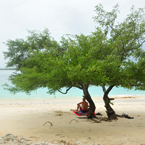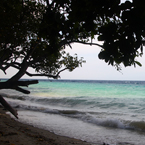Moluccan
Islands (Moluccas, Maluku)
The Maluku Islands (also known as
the Moluccas, Moluccan Islands, the Spice Islands)
are an archipelago that is part of Indonesia, and
part of the larger Maritime Southeast Asia region.
Tectonically they are located on the Halmahera Plate
within the Molucca Sea Collision Zone. Geographically
they are located east of Sulawesi (Celebes), west
of New Guinea, and north and east of Timor. The
islands were also historically known as the "Spice
Islands" by the Chinese and Europeans, but
this term has also been applied to other islands
outside Indonesia.
Most of the islands are mountainous, some with active
volcanoes, and enjoy a wet climate. The vegetation
of the small and narrow islands, encompassed by
the sea, is very luxuriant; including rainforests,
sago, rice and the famous spices - nutmeg, cloves
and mace, among others. Though originally Melanesian,
many island populations, especially in the Banda
Islands, were killed off in the 17th century during
the Spice wars. A second influx of Austronesian
immigrants began in the early 20th century under
the Dutch and continues in the Indonesian era.
Administratively, the Maluku Islands formed a single
province from 1950 until 1999. A new province of
North Maluku was created in late 1999 and incorporates
the area between Morotai and Sula and its capital
is Ternate. It is predominantly Muslim, although
it has Christian enclaves including in northern
Halmahera. Maluku Province includes the arc from
Buru and Seram to Wetar with its capital in Ambon.
Spice Islands most commonly refers to the Maluku
Islands and often also to the small volcanic Banda
Islands, once the only source of mace and nutmeg.
This nickname should not be confused with Grenada,
which is commonly known as the Island of Spice.
The term has also been used less commonly in reference
to other islands known for their spice production,
notably the Zanzibar Archipelago.
(Source: Wikipedia.org)
|
















